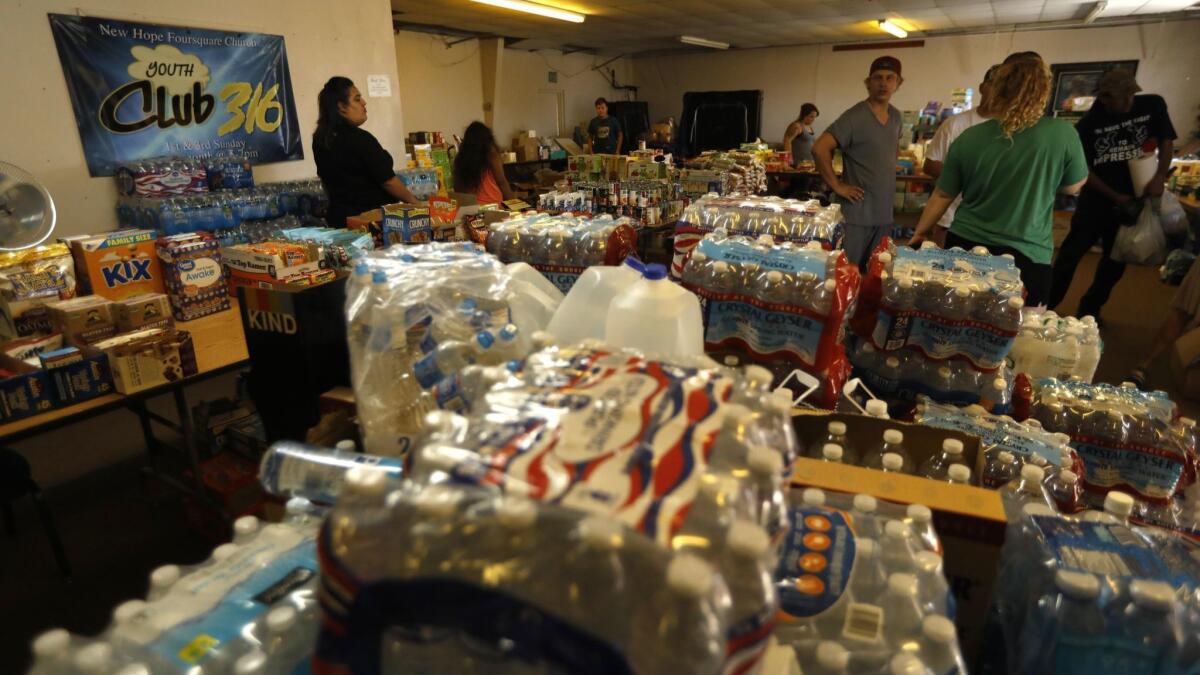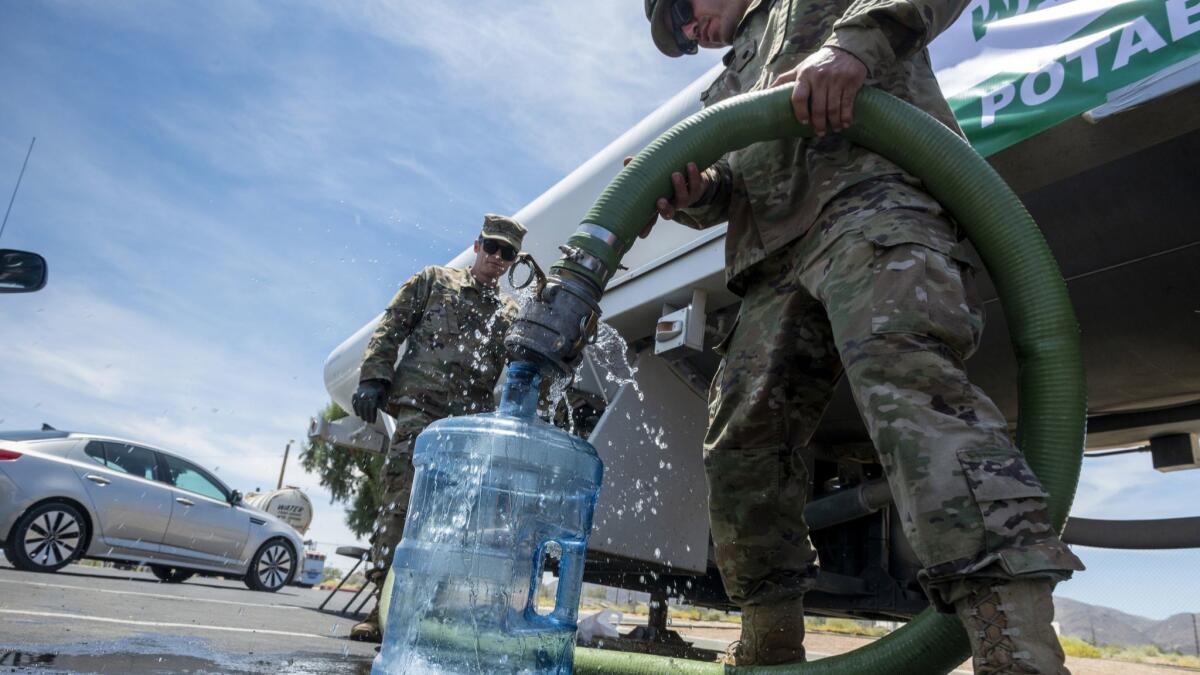Even after huge earthquakes, much of Southern California still unprepared for The Big One

- Share via
A sizable crowd had already gathered outside the Surplus Store early July 6 when Victor Hernandez arrived at the West Los Angeles shop to unlock the doors.
An orange banner strung between two white columns advertising earthquake and survival supplies in large block letters welcomed the nervous throngs as they filed in. Dozens packed into a single aisle in the spacious shop, grabbing boxes of prepackaged earthquake kits, bags of filtered water and freeze-dried meals with labels that boast of a lengthy shelf life.
“We were really sweating bullets,” Hernandez, a 26-year store employee, said. “By the end of the day, we were pretty much cleaned out.”
The same scenario played out at stores across Southern California all weekend following a magnitude 6.4 earthquake on the morning of July Fourth that struck about 125 miles northeast of Los Angeles and a larger temblor— a magnitude 7.1 —that hit a day later in the same location, near the Mojave Desert town of Ridgecrest.
But if history is any indication, the interest in seismic safety will be fleeting.
Despite all the warnings that the Big One is coming, officials have long struggled to get Californians ready to survive a major quake. There are relatively easy things that can be done, such as packing emergency kits with food and supplies, as well as more complicated — and expensive — tasks, including buying earthquake insurance, retrofitting homes and strengthening structures against violent shaking.
“It seems to always catch us off guard, and it shouldn’t,” said Reshan Dennis, a 16-year employee at the Surplus Store. “It makes you wonder how many of us are really prepared. Probably not a lot.”
The reality that a similar-sized earthquake in Los Angeles, a far more densely populated area than Ridgecrest, would do significant damage resonated with some in the days after the twin quakes. But that fear — which can send people running to the store for bottled water and canned food — is fleeting for most people, said Richard John, a professor of psychology at USC.
“A year or two from now, when the kit needs to be replenished, are they going to have the same feeling? Probably not,” he said. “So the cycle continues. In general, people have built up a sort of sense of resilience that this is just not something they need to worry about.”

California had been in a lengthy earthquake drought before the magnitude 6.4 quake. Light shaking was felt across Los Angeles, more than 125 miles from the epicenter, but the temblor didn’t cause significant damage, so few rushed out to bolster their emergency supplies.
Then the 7.1 quake struck, reclassifying the earlier temblor as a foreshock.
The phenomenon — and the complacency — isn’t exclusive to California.
Dave O’Brien, who manages the Orange Army Navy store, said the shop, nestled between an antiques store and a cafe in the heart of Old Towne Orange, was nearly empty July 5 after the holiday quake.
One day later, though, he found himself overwhelmed — and the store understaffed. A crush of people turned out and O’Brien said they couldn’t buy earthquake kits fast enough.
“Our sales totals were double what we normally do,” he said. “It’s finally good to see people getting prepared. Unfortunately, it’s not enough. They’re not really gathering the right amount that they’re going to need if the Big One ever hits in our lifetime.”
Customers gravitate to prepackaged kits that contain a few days’ worth of food, water and some essential first-aid supplies because they’re convenient. The kits are helpful in a smaller-magnitude quake but won’t last long after a major shaker that causes widespread damage and forces people from their homes, O’Brien said.
He scrambled to restock the store as more people trickled in to get supplies last week. After a few days, the crowds had thinned considerably, and he expects most will be gone completely within a month.
“People have short memories — even about earthquakes,” he said.

It’s not just emergency supplies that Californians are lacking. According to the Department of Insurance, only about 21% of homeowners in L.A. and Orange counties have coverage for quake damage. The figures drop considerably in the Inland Empire, with only 9% of Riverside homes covered and 8% in San Bernardino.
Before July Fourth, it had been almost five years since the state experienced an earthquake of magnitude 6 or stronger. Experts had said the period of calm was sure to end, and when it did, it would likely bring destruction.
Sometimes, a moderate quake — after a series of aftershocks — can lead to a period of seismic quiet, seismologists say. Other times, it can usher in a new era of temblors, sometimes with increasing intensity.
But denial has always been an aspect of living in earthquake country. And memories fade even during big quakes.
The devastating 1933 Long Beach quake prompted new seismic building codes for schools, but many other structures remained vulnerable.
In the 1980s, Los Angeles passed an ordinance requiring the retrofit or demolition of about 8,000 older brick buildings that could collapse during an earthquake. Yet other cities, notably in the quake-prone Inland Empire, have not followed suit.
California was hit by two devastating quakes in a five-year period — the Loma Prieta in Northern California in 1989 and the Northridge quake in Southern California in 1994. Both temblors prompted efforts to reinforce freeways and other types of construction.
But efforts in L.A. to tackle dangerous concrete building failed.
It would take nearly two decades for the city to require retrofits of concrete as well as soft-story apartment buildings, two types of structures that failed in 1989 and 1994.
People who experienced the severe quakes of decades past in Southern California are more likely to be concerned after a more moderate temblor. On the other hand, someone who has lived through a bunch of small earthquakes that don’t wreak havoc are less likely to worry about future episodes, John said.
Mary Jeffers, 85, who has lived in Ridgecrest since the 1960s, admits she falls into the latter category. The wave of aftershocks that followed last week’s quakes didn’t scare her in the slightest.
Earthquakes come with the territory, she said. She had her house built with quakes in mind, so it’s sturdy and suffered only minimal damage in the latest shakers. But she’s never had an emergency preparedness kit and because most of the quakes in the area have been small, she says she likely won’t change anything about the way she lives.
“I guess I don’t worry a lot,” she said. “Maybe famous last words. Maybe I’m tempting fate.”
Times staff Writers Rong-Gong Lin II and Alejandra Reyes-Velarde contributed to this report.
Twitter: @Hannahnfry
More to Read
Sign up for Essential California
The most important California stories and recommendations in your inbox every morning.
You may occasionally receive promotional content from the Los Angeles Times.











